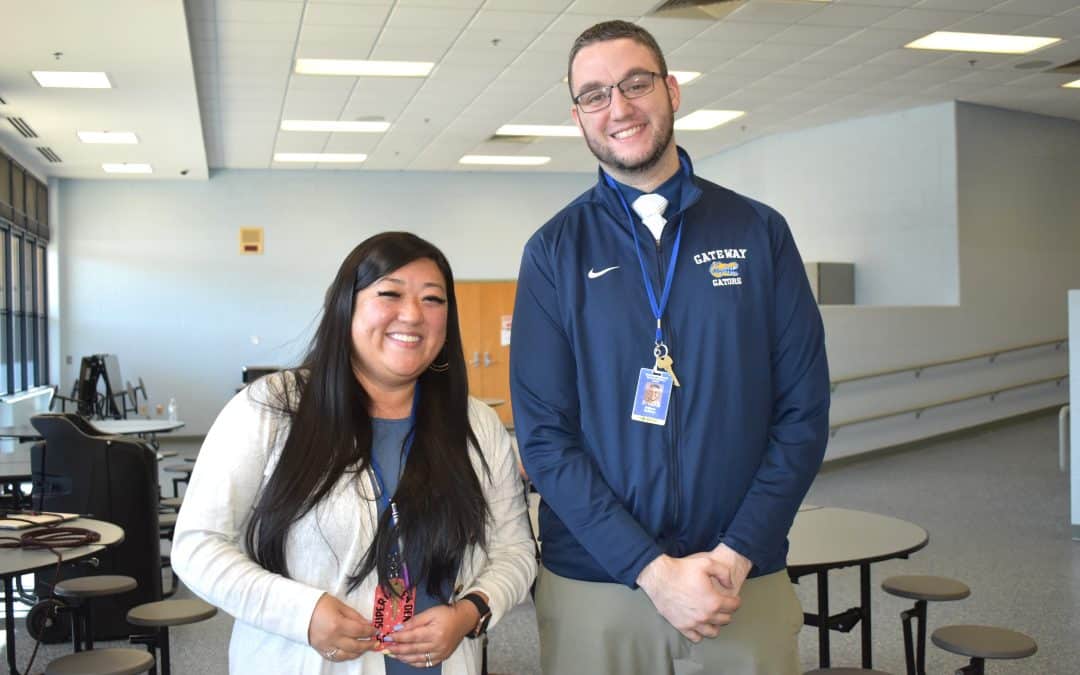HUNTINGTON — Gateway Regional School District administrators and teachers, who visited schools around the country during the “dream” phase of the Barr Foundation grant, related some of the programs that impressed them during a professional development day for staff on March 13.
The private Barr Foundation, based in Boston, awarded a highly competitive grant of $100,000 to Gateway in 2023. According to the Barr Foundation website, its goal in education is to “catalyze models through support for teams of educators to create a new vision for high school, plan for change, and implement new school designs.”
Superintendent Kristen Smidy said that 34 staff members have participated in visits from Maine to California, underwritten by the initial grant. The site visits will continue through the month of March, including a three-day trip to Vermont, which will offer opportunities for more staff to participate.

Reminder Publishing photo by Amy Porter
During the visits, Gateway staff were encouraged to seek answers to three questions they developed during the initial “learn” phase in the fall: “How do we build a school where everyone is invested in the student’s personalized learning experience,” was the first.
“We want to up the ante,” said Smidy.
They also asked how to ensure that students can build the future they want after graduation, and how to design a system where everyone is working together with a strong sense of purpose.
“In the ‘dream’ phase, Barr encouraged us to catch as many butterflies as we can,” Smidy said. Beginning in April, the team will begin to prepare a plan to implement some of the ideas they saw that might work for Gateway, to present to the foundation in June for future funding.
Smidy said the ratio for implementation of new ideas will be about “80% [to] stay the same; 20% to try something new,” which she called a manageable ratio.
Some of the ideas shared during the presentation included a school with “pathways,” to allow students to minor in a subject they were interested in pursuing by taking two or three courses in it. One school offered as many as 17 pathways for students.
In Colorado, participants saw an example of the “crew” model in a high school where each class stayed all four years with the same lead teachers, who they relied on to help them select classes.
“It was all about relationships,” said one participant, adding that the school credited a lack of behavioral issues to the crew model.
The emphasis in another school was on standards-based grading, which they said was all about performance, and mastery of standards. The teachers focused on priority standards. One Gateway presenter commented, “I like the acknowledgement that everybody learns at a different pace; it creates a better sense of purpose. Students know exactly what they need to do to pass the class.”
Another said it avoided the emphasis on making sure assignments were turned in on time.
“Looping” is another high school model they saw, which involves six multi-age classrooms, where teachers got to know students over two years, which they said cut out the beginning-of-the-year “getting to know you” time.
In Casco Bay, Maine, the school they visited had week-long “intensives” during the year, in which teachers chose an area of interest to take their class through for a week, as another way to offer electives. The week-long intensives were also a way to offer recovery credit for classes that students had failed. Gateway staff said candidly the teachers admitted it required a lot of work and planning, but was very rewarding.
Gateway is unique among Barr grant recipients because the entire school system is participating, from pre-kindergarten to high school. In a visit to an elementary school, staff reported that teachers were focused on specific content areas. For example, in a kindergarten classroom, one group studied English language arts and then switched teachers to go to math and science. They said the teachers enjoyed the focus.
After the presentation, staff gathered in small groups to discuss some of the models in more detail and to answer questions. Once the school enters the “plan” phase, the staff will be selecting ideas for potential implementation at Gateway, supported by future funding from Barr once the plan is accepted.
During a recent budget hearing, Smidy characterized the relationship with Barr as “an unknown with great potential.” The grant is not able to be factored in at all in the budget process. “The funding that they give us is required to just be allocated for innovation,” she said.
Smidy said she spoke to the foundation’s education director, who accompanied Gateway on a recent site visit. The director asked her what she was most worried about, and she responded, about Barr’s commitment to being a long-term partner with Gateway.
Smidy said the director told her not to worry about that at all. “She said, ‘we’ve just been so pleased with this partnership.’”
Smidy also recently spoke to administrators at the Mohawk Regional School District, which had received a Barr grant in a previous cycle.
“They totally changed their course, and Barr is still funding them,” she said.
William Sullivan, Gateway’s new middle and high school principal, accompanied the group on site visits to California and in Massachusetts to Kipp Academy in Lynn, and Mystic Valley in Malden, both charter schools.
Sullivan said he was impressed by the enthusiasm he encountered.
“The excitement of the students coming to school, excited about what they were learning,” he said. He said these schools were able to remove many tasks from the teachers’ plates, to allow them to focus on teaching, “doing what they do best.”
Smidy said what Sullivan was describing is a trend with high-engagement schools, a pulling away from regulations to meet students in a new and energetic way.
At the session, all of the staff were invited to a dinner and dreaming session with the Barr Foundation on May 2, to discuss the final proposal from Gateway. They were also invited to give feedback on the ideas presented during professional development.


